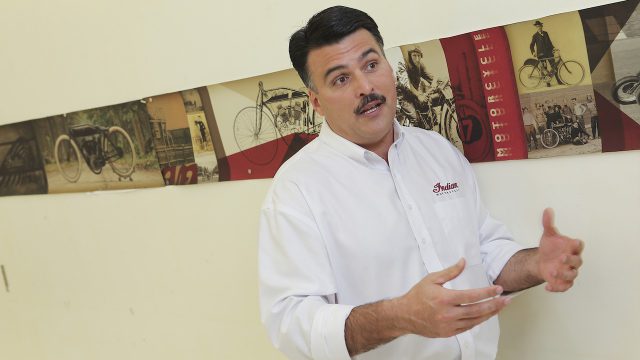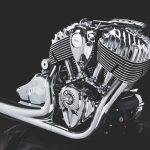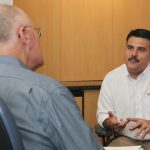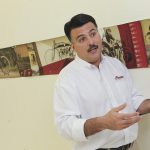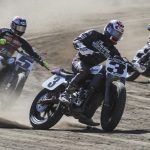Full background to the shock decision in January 2017 by Polaris Board to axe Victory via an 18-month wind-down, with positive implications for the Indian brand
Intensive, detailed, one-on-one interview with Steve Menneto, President – Motorcycles for Polaris, and the man spearheading Indian’s highly successful revival.
Steve Menneto, 51, is President of Motorcycles at Polaris Industries Inc., and as such he’s the man who together with Polaris President/CEO Scott Wine ultimately sold his colleagues in Polaris management the idea of acquiring Indian in April 2011 as a heritage marque to run alongside its much younger Victory brand. Having succeeded in doing so, Menneto was then entrusted with the task of making it work, and returning America’s oldest existing motorcycle company which built its first such machine back in 1901, to the marketplace. It’s a task he and his team at Polaris HQ in Medina, Minnesota have self-evidently discharged exceptionally well, in developing a strong-selling array of individually-styled and distinctively engineered models based on two engine platforms. These comprise the air-cooled ohv Thunder Stroke 111ci/1811cc 49º V-twin motor which kicked off Indian sales in August 2014 with the Chief custom and Chieftain bagger, followed by the Roadmaster tourer, and the liquid-cooled 69ci/1,133cc Scout 60º V-twin eight-valve engine which followed a year later to provide a less costly middleweight alternative from the tomahawk tribe.
These new Indian products have been marketed until now alongside the existing lineup of Victory models from the brand with which Polaris entered the motorcycle business in kicking off production in July 1998, and which the company had specifically declared it would continue manufacturing to provide a more youthful, performance-focused alternative to Indian, with more modern styling. But on January 9th this year, the shock news came that the Polaris Board had decided to shut down Victory after almost 19 years in the marketplace – a decision that came just two months after a full array of 2017 Victory models had been displayed on the Polaris stand at the EICMA Show in Milan.
Steve Menneto has a unique understanding of the powersports industry from both sides of the marketplace, having begun his business life as a Polaris dealer in New York, before crossing over to join the company in 1997 as a District Sales Manager, in due course becoming Director of Sales for the Polaris Motorcycle Division. He assumed overall responsibility for Victory Motorcycles in May 2009, and then after Polaris purchased Indian in April 2011 from British entrepreneur Stephen Julius’s Stellican Corp., was duly promoted to his current position as President – Motorcycles for Polaris. He has thus overseen running in tandem until now the Victory and Indian Motorcycle brands constituting the Polaris motorcycle division, whose revenue is forecast to grow to $1 billion in the next five years, up from $708.5 million in 2016. Who better to ask about the demise of Victory – as well as his plans for Indian’s future, which this year have included bringing what was once America’s most famous competition brand back to the racetrack.
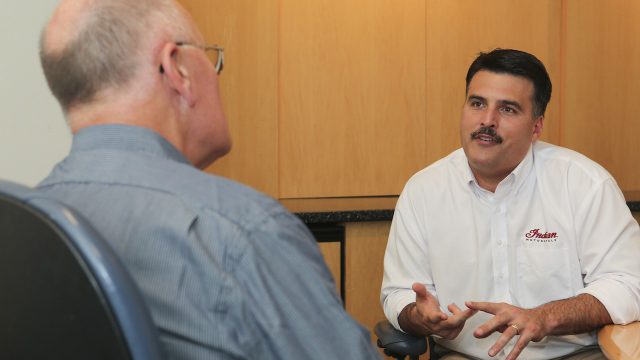
AC: Steve, why has Polaris shut down Victory, and then did you take that decision?
SM: The Polaris Board began a discussion last year about where our motorcycle division was going in the next five years, and how we were going to move forward with two brands in a highly competitive global marketplace. As part of that, I was challenged to put together a 5-10 year plan for Victory, which had lost well over a hundred million dollars thus far in its 18 years of existence. When we put all the numbers together, it just came down to where Victory was going to have some years of marginal profitability, but in totality was going to continue to lose money over the coming years. This was because of the considerable engineering investment needed to develop new products in future, which would probably entail new platforms because the Victory Freedom V-Twin engine had been with us for almost 20 years, and there would be untenable costs entailed in meeting the new Euro 4 and Euro 5 regulatory standards. So we presented those findings to the Board, and at their meeting in the first week in January they moved to approve an 18-month wind-up of Victory, which we then communicated publicly at 8.15am on Monday 9th.
One of the most frequent comments that we’ve been hearing since then especially from Victory dealers was, why didn’t you give us any more notice? Well, you have to remember we are a publicly traded United States company, and when you make a decision of materiality as significant as this, there are certain procedures you’re obliged to follow. Where decisions that could affect stock prices are concerned, market rules are strict – they must be made public straight away. Some dealers and a good handful of consumers sent emails that were pretty unfavourable, but while they didn’t like our decision I can assure you that it was not one taken lightly. It was a tough decision to make, but the right decision, and it was painfully and carefully arrived at after a great deal of discussion. It’s no secret that the motorcycle market is tough here in the United States right now, and we have to look at where the best return can be found on capital invested. We can get better returns for our stakeholders – and our dealers, too – by focusing on the excellent business that Indian Motorcycle represents for us, so in the end market conditions made it a simple but tough decision. Some of the emails I received told us we ought to have put more effort into growing Victory, but when you look at the two decades of continuous hard work that we’ve invested in the brand, the diverse products we came out with, and the way they were judged to be No.1 for quality in the US motorcycle market, you can’t say we didn’t put everything we could, including money, into growing that brand and its products.
AC: Was Victory ever profitable in its 18 years of existence?
SM: There were a couple of years when it was profitable for that specific year [believed to be 2010-11-12, when Victory sold around 13,000 motorcycles annually – AC], but in its overall totality, no.
AC: You have a 402,525ft² motorcycle factory at Spirit Lake, Iowa with three production lines, which currently houses 800 employees manufacturing both Victory and Indian products. Will this impact the Victory workforce there, or will they simply be reassigned to manufacturing Indians?
SM: The engineers and sales force of Victory have all been reassigned, and the manufacturing facility’s workforce was not hit badly – less than 50 people were let go. Half of that number were offered early retirement, and the rest were temporary employees, so the impact on our employee base was not dramatic.
AC: How many Victory motorcycles have been manufactured in total?
SM: Since its inception, our teams have designed and produced almost 60 Victory models that have been honoured with more than 25 of the industry’s top awards. We built well over 125,000 Victory vehicles throughout the 18 years of its existence, and a significant number of them are still out there running. We will be supporting them by continuing to supply parts and providing service and warranty backup for a period of 10 years into the future – they’ll be gone, but not forgotten. We’ll also assist dealers in closing down their operations, and liquidating their existing inventories. .
AC: Is it safe to say that Polaris would have never taken on Indian if you had not already had Victory, and thereby acquired a hands-on understanding of the motorcycle industry?
SM: I think it’s exactly fair to say that, Alan, and furthermore those 18 years of learning how to develop, manufacture and distribute Victory motorcycles were a priceless asset in bringing Indian to market as quickly as we did, with such reliable and well received products. You’ll recall the issues we had with the V92C Cruiser we started out with, and how our market presence really jumped forward when the entirely revamped Vegas came out in 2003 to replace it. All the knowledge that we acquired throughout those years with Victory was invaluable when it came to purchasing Indian, and to building up the Indian brand over the past three years to where it is now very much profitable for us. The experience we gained with Victory allowed us to go forward faster with Indian, and indeed without already having had more than a decade in the motorcycle business, I’m not sure we’d have felt quite as confident as we did about buying Indian in the first place. It was Victory that gave us the production, engineering and dealer development experience we needed to do so, and we expect that experience to be a gift that keeps on giving for some years to come. We increased the size of our motorcycle business tenfold from 2009 to 2016, and we’re just getting started!
AC: Will any of Victory’s existing or future models that are nearly ready for launch be rebadged as Indians?
SM: That’s the most common question I get asked by customers, and the answer is no, because we must maintain the authenticity of the Indian brand. Some people ask, why can’t you take the Victory Vegas or the Gunner and don’t change anything, except just remove the Victory badge and put Indian on it instead. Well, we shan’t do that because I think it would dilute the Indian brand. What we want to accomplish with Indian is different than what we achieved with Victory. OK, lots of Victorys have longer frames for bigger people, and Victory also had more modern styling than Indian presently has. So over the next two to five years you’re going to start seeing Indian models appear that will have some of those Victory characteristics in them, but will have still been developed all-new from the ground up. We won’t get into rebadging anything, but in going forward we’ll be using the know-how and styling cues derived from Victory in producing new Indian models.
AC: OK – but when you purchased Brammo in January 2015 as your ready-made electric motorcycle brand, that time you did then rebadge this as a Victory. How many Victory electric bikes have you sold since then?
SM: To be perfectly honest, less than 100 bikes so far.
AC: So now that Victory is gone, are you going to continue with electric motorcycles at all?
SM: Yes, indeed we will. We can see a lot of future opportunity for electric motorcycles as battery technology continues to move forward. So if you’re asking if we’ll just take the Victory Impulse and turn it into the Indian Impulse, the answer is no. We’ll actually have an Indian on-road electric bike within the next five years, with powertrain characteristics more applicable to leisure riding than commuting. .And it will be priced competitively.
AC: So what you’re essentially saying is that in the short term, Brammo models were rebadged as Victorys with a small amount of Polaris input – but with the death of the Victory brand you’ll terminate that programme, and work instead on bringing an all-new Polaris-developed electric platform to the marketplace as an Indian E-motorcycle within the next five years?
SM: Correct.
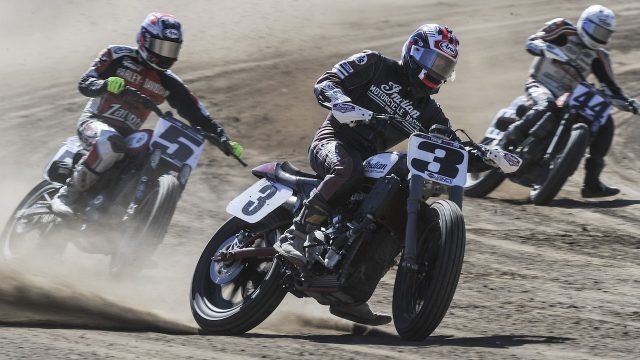
AC: What are your other strategic plans for Indian into the future?
SM: Indian finished 2016 up more than 25% year on year in retail sales. So we’re really excited about where we are with the Indian brand, and we’re optimistic about what we have coming up in 2017, with several exciting new bikes, new dealerships and so forth. With only nine models out there at present, we feel we still have a lot of strategic opportunities in front of us as we continue to look for aggressive expansion with high double digit growth, and we come close to doubling the Indian range of models.
I think what’s exciting is that when you look at where we want to take Indian in the next two to five years it entails different geographies and different segments that we currently don’t serve. So when you look at the Cruiser/Bagger/Tour segments which have a predominantly North American focus, this is what we needed to have in getting Indian started as a business. In our first three years of Indian production up until now, we’ve had to establish a dealer base, we’ve had to get products to market, we’ve had to develop accessory and apparel catalogues – all since purchasing the brand in 2011. But in the next three to five years we plan to improve our game still further, and grow our business dramatically – and that will includes launching bikes outside of the Cruiser/Bagger/Tour markets. It will include different model segments, sold in different geographic areas around the world. About 25% of our motorcycle business is international right now, and growing that substantially is a major objective for us, alongside continuing to build our North American base. We have an opportunity now to develop market specific models for Europe, as well as the USA. We’re excited about where we’re going over the next five years, now we can focus exclusively on Indian.
AC: I guess Indian has a very diverse potential product base, because you’ve only got to look in the history books to see how many different engine platforms Indian has had down the years.
SM: I concur with you – when you look at our history and all the different innovation that Indian did, we as a team don’t see Indian handcuffed or restricted by anything. So when we do look at entering other different segments, it can be rather exciting. When you see what we have done in a short time with the FTR750 flat-tracker, you can only imagine the different directions that engine can go in from being a pure racetrack platform. So I can tell you that we are looking at all different segments where we can bring value to the customer, and where we can bring Indian’s potential for innovation to the marketplace, in order to make great bikes to be ridden and enjoyed. I think everything is an opportunity for us with Indian as we look forward, and one of the things that follows from our decision to terminate Victory is that it has opened up the opportunities for Indian very nicely in terms of developing bikes that are quite different and more modern in design and styling. Some of them may now be more race focused, more aggressive and more performance based, without us saying – hey, we mustn’t let Indian stray onto Victory’s turf! That’s all behind us now.
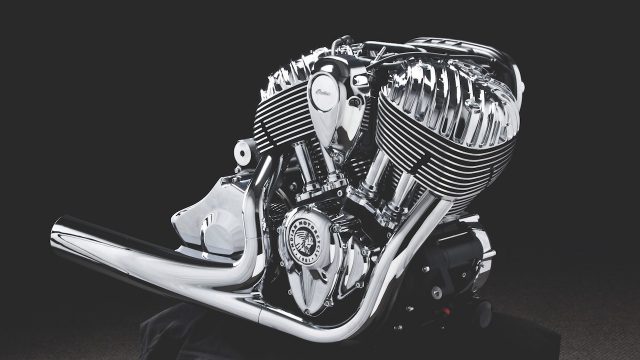
AC: So with the demise of Victory – which was considered to be the modern brand in the Polaris two-wheeled offering – you can now spread Indian right across the marketplace. Could that include a dual-purpose model for the Adventure Sports market to rival the globally best-selling BMW R1200GS?
SM: There are absolutely no restrictions on what kind of motorcycle we can make in future with an Indian badge on it, and we plan to take full advantage of that freedom to produce a range of innovative products that will be fun to ride, as well as great to look at. Remember that Indian developed its first motorcycles as a way of getting around when there were hardly any roads as we know them today. So I certainly believe Indian can look at markets like that one.
AC: The Triumph Bonneville has enjoyed massive sales success around the world as a mid-capacity retro product, to the point where Ducati has tried to emulate it with their Scrambler models. Do you think their 800cc category is a field where Indian can potentially be involved?
SM: Yes, I think Indian can bring interesting products to such a segment.
AC: Following on from that, the FTR750 flat track motor is the smallest capacity Indian engine yet. While it’s starting out powering a competition motorcycle, do you plan to develop a street range based on that?
SM: I think that’s a platform where we can see a lot of opportunity in it, and we have some great plans to use it in bringing different types of bikes to the market for Indian.
AC: So not just a flat track replica, but to use that engine for other different models?
SM: Well, that 750 is a race engine only, but there’s other opportunities for us to develop new products based on what we learn in building smaller engines. We can see opportunities in other model sectors as we move down the capacity scale, where Indian will be indeed a player in the future.
AC: Victory was previously involved in competition, including Pike’s Peak, the Isle of Man TT Zero electric bike race, and of course NHRA drag racing. Indian is about to start out now with flat track racing, but do you see Indian taking part with any of Victory’s former competition activities?
SM: This has resolved some issues we had with some of the decisions that we made around Victory, and how it limited where we could go with Indian, and vice versa on occasion – Indian prevented where we could go with Victory, in some cases. Well, as we look at it now we have the opportunity to take Indian drag racing, to do Pike’s Peak, to go to the Isle of Man and to continue to expand our competition activities with what is now our single brand. We shouldn’t forget just how central race success has always been to Indian’s appeal to the customer. As we start our flat-track campaign, you’ve seen the quality of the bike and the quality of the team, and as we move forward you’ll see us continue to evolve the competition side of our brand with great bikes, and great riders. Indian will be very competitive as we enter those different sporting arenas – but only with the highest level of equipment, and personnel.
AC: Do you feel that in cleaning up your motorcycle business by focusing entirely on the Indian brand in future, this will make it easier for you to market Indian to a broader range of customers? Victory was supposed to be the younger enthusiast product, and Indian the more traditionalist. Well, now that you only have the heritage brand to focus on, do you believe you‘ll be able to attract younger customer to Indian more readily with a broader range of products?
SM: I do, Alan, I think that the richness of the Indian brand heritage, the innovation of the brand and what it speaks to in terms of product will help us achieve that – and you’re right to identify that as a crucial aspect of our plans going forward. A lot of the feedback we’ve got over the past three years from younger riders – especially after we launched our Scout product – is that there’s already an appetite and a desire for them to be a part of the Indian motorcycle family. I think with our decision to focus on this one brand, we have an opportunity to expand Indian considerably in terms of the brand story, the innovation and where we want to take it. You’ll see our product range expanding in terms of more modern offerings in different segments, plus with our going racing competitively with Indian, I think we’ll have a brand image that will appeal to a broader spectrum of customers. I think we have a very bright future ahead now we can focus exclusively on Indian.
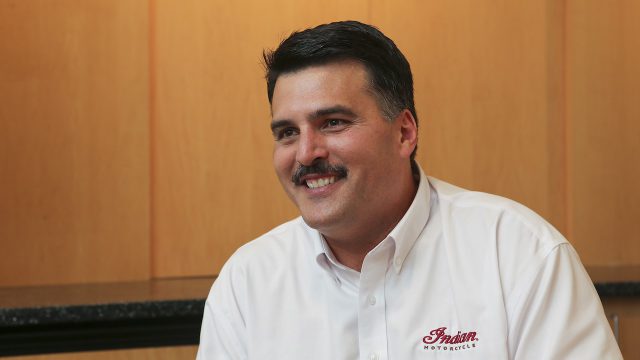
* * * * * Photo credit: Kevin Wing (portraits)
